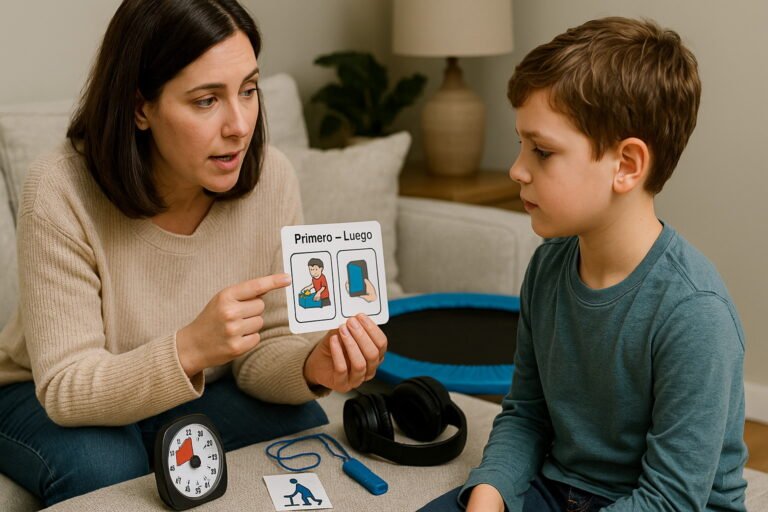Correcting isn’t scolding; correcting is teaching. In autism, plain scoldings and a blunt “NO” often raise stress and worsen behavior because they don’t explain what the child should do. This step-by-step guide helps you prevent blowups, teach skills, and get real change.
Why “NO” Doesn’t Work
It doesn’t say what to do
“DON’T shout” doesn’t teach the right volume. “DON’T run” doesn’t teach how to walk.
It raises anxiety
A loud tone, harsh words, and a stern face can trigger sensory/emotional overload.
It makes processing harder
Many autistic children process language more literally and more slowly. Long or negative sentences confuse.
It interrupts without offering control
Abrupt changes (taking away, stopping, “now”) without alternatives increase the feeling of losing control.
Keys: Instead of “NO,” describe the correct action in a few words and, if you can, show it (gesture, pictogram).
Master Principle: “Say What TO DO”
- Instead of “Don’t shout,” say: “Soft voice, like this.” (model with your voice)
- Instead of “Don’t hit,” say: “Hands down. If you need strong input, push the wall for 10 seconds.”
- Instead of “Don’t throw,” say: “Balls go in the basket. I’ll show you.” (point or guide the gesture)
Golden rule: Use 6–8 words, one single step, calm tone, and visual support whenever possible.
What to Do in the Moment (after the behavior already happened)
Lower the input
Calm voice, few words, safe distance; reduce noise/light if possible.
Brief co-regulation
“I see you’re upset. I’m here.” Offer a PAUSE (take 3 breaths, squeeze a ball, push a wall for 10 s, headphones).
If there’s a tantrum: remove dangerous items and keep supervision at a distance. Let them calm down without intervening or talking. When the body is calm, explain positively what you want them to do next time.
Positive instruction + equivalent alternative
“Hands down. If you need pressure, squeeze this ball.”
Finish with a small success
“Now put the piece here (point). All done!” Reinforce: “Great using calm hands.”
Real example (shouting):
“Soft voice, like this.” (lower your voice) → “Breathe with me 3…2…1.” → “Now raise your hand to take a turn.”
Reinforcement: “Excellent asking for your turn!”
How to Prevent (when the child is calm)
1) Anticipate and structure
- First/Then: “First put away for 2 minutes, then tablet for 5.”
- Visual schedule: pictures/photos of what will happen.
- Transition warnings: 5–2–0 minutes with a visual timer.
2) Visible positive rules (3–5)
“Soft voice” · “Calm hands” · “Ask for help.” Post them where behaviors happen.
3) Practice when calm (5-minute role-play)
Practice asking for a pause, waiting for a turn, raising a hand, walking slowly.
4) Offer control with two good choices
“Shower now or after the song?”
“Homework with help or for 5 minutes on your own?”
5) Reinforce what you want to see
Immediate and specific: “Great soft voice when talking to mom.”
Use a simple point card: 3 ✅ = 5 min of their preferred activity.
Model Phrases (short list for the fridge)
- “Do it like this: hands down.”
- “Soft voice (like me).”
- “First put away, then tablet.”
- “Ask for a turn with your hand.”
- “Pause: will you breathe 3 times with me or squeeze the ball?”
Guides for Common Situations
A) Hitting / pushing
Say: “Hands down. If you need strong input, push the wall for 10 seconds.”
Then: Practice the alternative—asking for deep pressure or a bear hug (if tolerated and with consent).
B) Shouting
Say: “Soft voice, like this.” (model) + “Take 3 breaths with me.”
Then: Reinforce the first attempt to lower volume.
C) Throwing objects
Say: “Balls go in the basket. I’ll show you.”
Prevention: Provide a safe throwing area (bin/mat) for 2–3 timed minutes.
D) Refusing a transition
Say: “First shoes, then music in the car.”
Graduated help: You put on one shoe, they put on the other. Use a visual countdown.
E) Constant interruptions
Say: “Ask for a turn with your hand.” (show pictogram)
Reinforcement: Give the floor quickly the first times to consolidate the skill.
If the Behavior Is Dangerous
Safety first
Clear objects, increase distance, use light blocking only if there’s immediate risk.
Short instruction + gesture
“Calm hands” (show hands down).
After securing the environment, if the tantrum continues, allow the child to self-regulate without interaction. Don’t try to reason at the peak. When they’re down to level 1–2 on the emotion scale, teach the alternative (what to do) with a brief practice.
Then, teach the equivalent alternative (e.g., “I need deep pressure”).
Common Mistakes (and How to Fix Them)
- Saying only “NO” → Switch to “Do X like this.”
- Long/abstract phrases → Use 6–8 words and one step.
- Long punishments → Replace with teaching + reinforcement.
- Removing special interests as a constant “punishment” → Use them as regulation and planned reinforcement.
- Expecting compliance without supports → Add visuals, choices, and processing time (5–10 s).
- Talking/reasoning during a tantrum → Fix: secure the environment, let them calm without intervention, and teach later with a positive instruction.
7-Day Quick Plan (10 minutes a day)
Day 1: Define 3 positive rules and post them.
Day 2: Create 3 typical First/Then cards.
Day 3: Teach Pause (breathing / ball / wall).
Day 4: Practice Asking for a turn (hand/pictogram).
Day 5: Rehearse transitions with a timer.
Day 6: Implement reinforcement (3 ✅ = 5 min).
Day 7: Review triggers and adjust supports.
Quick Questions
When do I correct?
First regulate (lower emotion), then teach. During the peak, use few words.
What if “NO” already slipped out?
Rephrase immediately: “Do it like this: soft voice.” and model.
What if nothing works?
Reduce the demand (less time/steps), add modeled/physical help, and reinforce every small step forward.
Ready-to-Use Script Examples
1) At home (throwing things):
“Pause: take 3 breaths.”
“Do it like this: pieces go here.” (point to the drawer)
“First put away for 2 minutes, then 5 minutes of tablet.”
“Great putting away. Here’s your ✅.”
2) At the store (shouting due to a change):
“Heads up: 2 aisles and then juice.” (show fingers)
“Soft voice like me.”
“Choice: help push the cart or count items?”
3) At school (interruptions):
“Ask for a turn with your hand.” (show pictogram)
“Now it’s your turn. Thanks for waiting.”
“✅ for calm hands and soft voice.”
Adult Checklist
☐ Did I say what to do?
☐ Did I use few words and a gesture/visual?
☐ Did I offer a pause or equivalent alternative?
☐ Did I allow 5–10 s for processing?
☐ Did I reinforce the right behavior immediately?
☐ Did I adjust the demand if it was too hard?
☐ Did I secure the environment and let them calm before teaching?
Closing:
The goal isn’t to “turn off” behaviors, but to teach replacement skills: asking for help, self-regulating, waiting, shifting tasks, and communicating needs. When you replace “NO” with clear instructions, visuals, choices, and reinforcement, and let them calm before teaching, children understand better, self-regulate faster, and the day flows.












